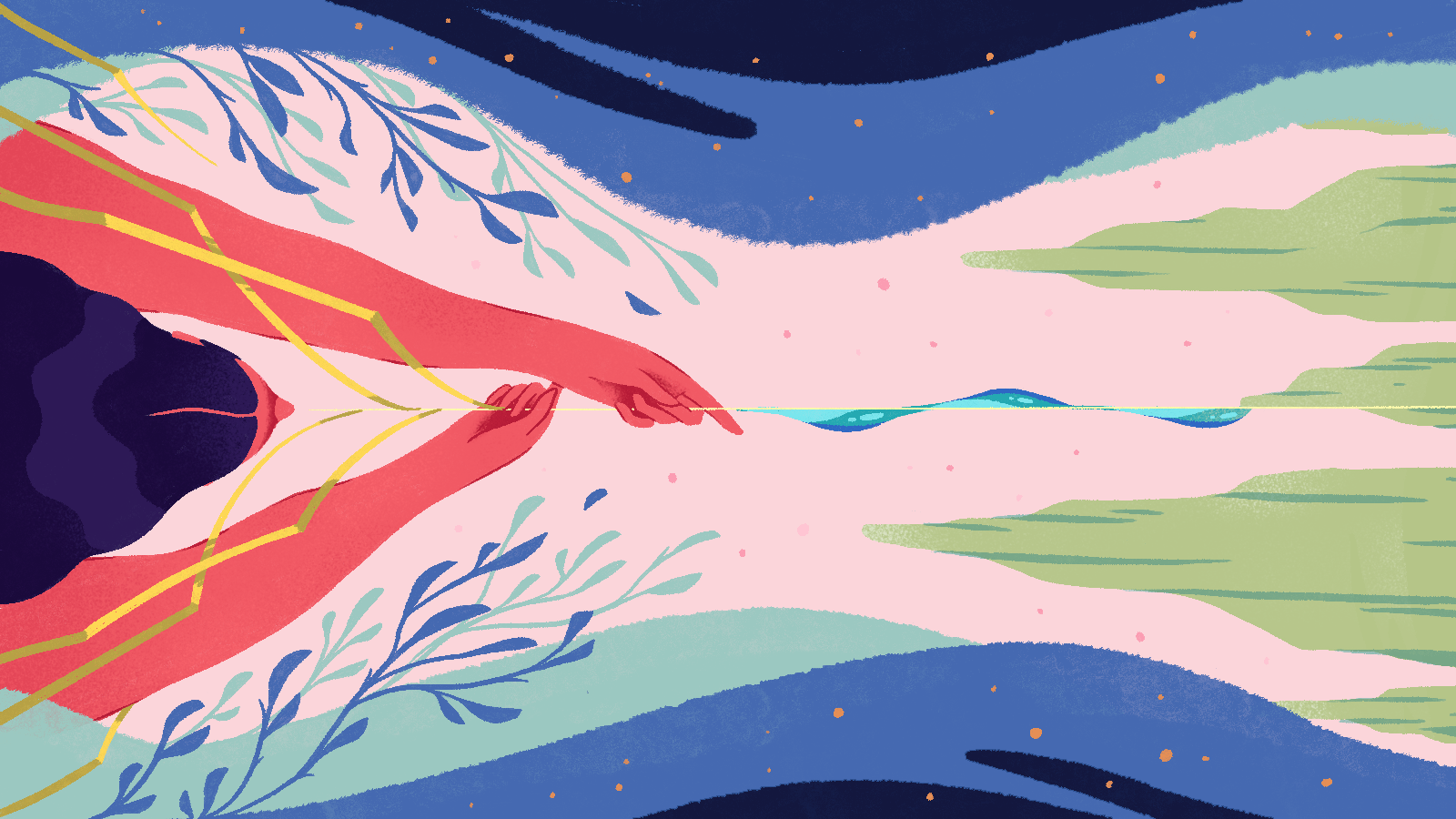Sarena Ulibarri is a fiction writer whose work has appeared in Lightspeed, DreamForge, Weirdbook, and other magazines and in several anthologies, including Biketopia: Feminist Bicycle Science Fiction Stories in Extreme Futures. She is editor-in-chief of World Weaver Press and returns as a story reviewer in our climate fiction contest Imagine 2200.
There are people all over the world who believe a just and sustainable world is possible. Maybe you’re one of them. Oh, the details of how that world works will vary according to our individual priorities and values, not to mention the physical and political climate of where we live. But we share the same vision: a future in which we’ve tackled the environmental and social justice issues of our time in a way that brings humanity, nature, and technology into harmony. We dream of green, community-centered cities; of high-tech, ethical farms; of pollution-free skies and plastic-free oceans. We dream of a world of abundance and inclusion, with equitable resource distribution and flattened hierarchies. We know we can’t achieve this by following the same path we’ve been walking; we must work together to blaze a new and better trail.
We are artists and writers and musicians. We are activists and community organizers and urban planners. We are architects and scientists and engineers. We are gardeners and gamers and makers.
We are the solarpunks. You might be one, too.
The term “solarpunk” first appeared in 2008 in an anonymous blog post that proposed a new literary genre focused on sustainable technology. Four years later, Brazilian editor Gerson Lodi-Ribeiro published the first anthology of solarpunk fiction, which was subsequently translated into English. But the idea really caught on in 2014 after a Tumblr post by the blogger and artist Miss Olivia Louise, who suggested combining solarpunk with an art nouveau aesthetic. More artists and writers began creating works in this style to give life to the idea, and the term also caught the attention of other movements with a similar vision. Solarpunk quickly grew beyond art, integrating with real-world activism and praxis as a paradigm to envision real futures as well as fictional ones. For practical inspiration, solarpunk looks to permaculture and Indigenous agriculture, sustainable architecture like Earthships and Arcosanti, as well as the maker movement and DIY culture. The future-focused inspiration has roots in the work of science fiction writers like Ursula K. Le Guin, Kim Stanley Robinson, and Octavia E. Butler, all of whom explore climate change, alternative economies, and equitable community in their work.
What started as an idea for a new approach to science fiction has evolved into a worldwide community. We occupy a corner of every major social media platform; the community and concept have evolved through online discussions. Though we sometimes disagree about what a solarpunk world looks like, we are united by our vision of a future based on hope. But “hope” is a tricky concept. It can be a catalyst for action, or a crutch supporting denial. Hiding from horrid realities or deluding ourselves that everything will turn out OK is not the type of hope solarpunks embrace. We know that climate change is here, and we acknowledge how bad it could get. We accept that tough times lie ahead, and imagine ways of adapting to those challenges with resilience, compassion, and equity. We’re rethinking how we live our lives and how we organize our societies, trying to reshape our systems so they serve the needs of the many instead of the wants of the few. We’re rethinking our relationships with technology and with nature, searching for a sustainable balance between the two.
Why “solar”? Why not “eco” or “green” or “climate” or any number of terms? Because a solar panel is the most easily recognizable symbol of renewable energy. Unlike a wind turbine or wave converter, solar arrays can be installed almost anywhere — on rooftops, carports, even backpacks and clothing. Whether you’re plugged into the grid or going off of it, solar panels create power as well as empowerment for those who benefit from them: a direct connection to the source of your energy. Solarpunk doesn’t make the claim that solar is the only answer to our energy needs. In fact, solarpunk art and stories often depict wind, kinetic, geothermal, biomass, and other renewables. “Solar” is a synecdoche for all sustainable technology. Beyond a solar panel’s practical application in helping us along the path toward a more sustainable future, the word “solar” works metaphorically as well. We’re talking about working toward brighter futures. Of course the sun makes a perfect symbol.
OK, but why “punk”? Although the ideas behind solarpunk have circulated for decades, the term gained momentum and coalesced into its current form among people familiar with aesthetic and literary traditions like cyberpunk and steampunk. The -punk suffix designates a world with a recognizable aesthetic. Steampunk, for example, is easily recognizable by its Victorian attire, goggles, steam-powered gadgets, and clockwork mechanisms. Think the 1999 film Wild Wild West or the book Boneshaker by Cherie Priest. Cyberpunk is characterized by its neon lights and rainy, dystopian, Asian-influenced megacities. Blade Runner is perhaps the most famous example of the style.
[Read next: From Afrofuturism to ecotopia: A climate-fiction glossary]
Do an image search of solarpunk, and you’ll mostly find the vegetation-covered, mixed-use cityscapes of Japanese artist Teikoku Shônen and the skyscraper ecodistrict concepts of Belgian architect Vincent Callebaut. Many also cite the cozy pastoral fantasies of Hayao Miyazaki’s Studio Ghibli as inspiration. Urban gardens and green rooftops, solar panels and helix wind turbines, biomimicry, and geodesic domes tend to be the most common components that will lead someone to hashtag an image as solarpunk. Just as “solar” means more than only solar panels, the green cityscapes of the solarpunk aesthetic are not meant to represent a singular vision of the future. Instead, they represent the core values inherent in solarpunk: sustainability, safe and equitable communities, and a healthy balance between nature and technology.
That’s not to say solarpunk is simply an aesthetic. The very word “punk” implies rebellion and anti-authoritarianism and pushing back against the status quo. One way this manifests is the decentralization of power, both in terms of energy and the political structures that control our societies. There is no place in a solarpunk future for autocrats, oligarchs, and fascists, just as there is no place for monopolies, resource hoarding, and artificial scarcity. The “punk” in solarpunk signals dissatisfaction with the capitalist vision of the future we’re being sold, and a desire to reimagine and remake an alternative.
Solarpunk looks past the disasters to the solutions, envisioning a different path from the one we’re told is inevitable.
While the first solarpunk stories from the Brazilian anthology Solarpunk: Histórias Ecológicas e Fantásticas em um Mundo Sustentável criticize renewable technology and argue that green capitalism does not ensure a just world, more recent solarpunk fiction tends to question the maintenance of the status quo that has created our current polycrisis. The novel New York 2140 by Kim Stanley Robinson, for example, takes place in a flooded Manhattan, showing a world where the same mistakes have been made over and over and people adapt to the consequences — until a community bands together to disrupt that pattern and create real change. Optimism, even hope, has become a hallmark that distinguishes solarpunk from other climate fiction, which usually seeks to raise awareness of environmental issues by focusing on disasters and the consequences of ecological collapse. Solarpunk looks past the disasters to the solutions, envisioning a different path from the one we’re told is inevitable.
[Read next: Fix’s Climate Fiction Issue]
Solarpunk authors do not always explain how their characters created the worlds they inhabit. Some of these worlds have fully transitioned to sustainable lifestyles, such as in A Séance in the Anthropocene by Abigail Larkin (published in Fix’s Imagine 2200 climate-fiction collection) or Caught Root by Julia K. Patt. Some take place in the midst of transition, such as A Worm to the Wise by Marissa Lingen (also a winning Imagine 2200 story) or my story The Spiral Ranch. Still others take those “punk” values to heart and show rebellion and underground organizations working against injustices, as in Imagine 2200’s winning entry Afterglow by Lindsey Brodeck or The Boston Hearth Project by T.X. Watson.
Solarpunk stories tend to envision problems holistically, understanding that social and environmental justice are deeply entwined. Some stories focus on practical solutions, while others show the outcome of the transition without explaining exactly how we got there. Both approaches can be inspirational. Simply exploring what it’s like to live in a clean, green, just world can inspire readers to think about the steps needed to get there. When we can see ourselves living in such a world, it’s more likely to feel real, to feel like a future worth fighting for.
So, what is solarpunk? An aesthetic, a movement, a genre of art and fiction, a belief system, a lifestyle?
Yes. All of the above. It’s a shared vision of a future world, and a community in which everyone contributes in whatever way they can. A label is only as valuable as its ability to communicate and organize. Use it if it resonates with whatever steps you’re taking to reimagine the future. The more voices that join this chorus, the more likely we are to collectively imagine a world that serves the needs of everyone who lives there.
The views expressed here reflect those of the author.
Fix is committed to publishing a diversity of voices, and we want to hear from you. Got a bold idea, fresh perspective, or insightful news analysis? Send a draft, along with a note about who you are, to opinions@grist.org.




